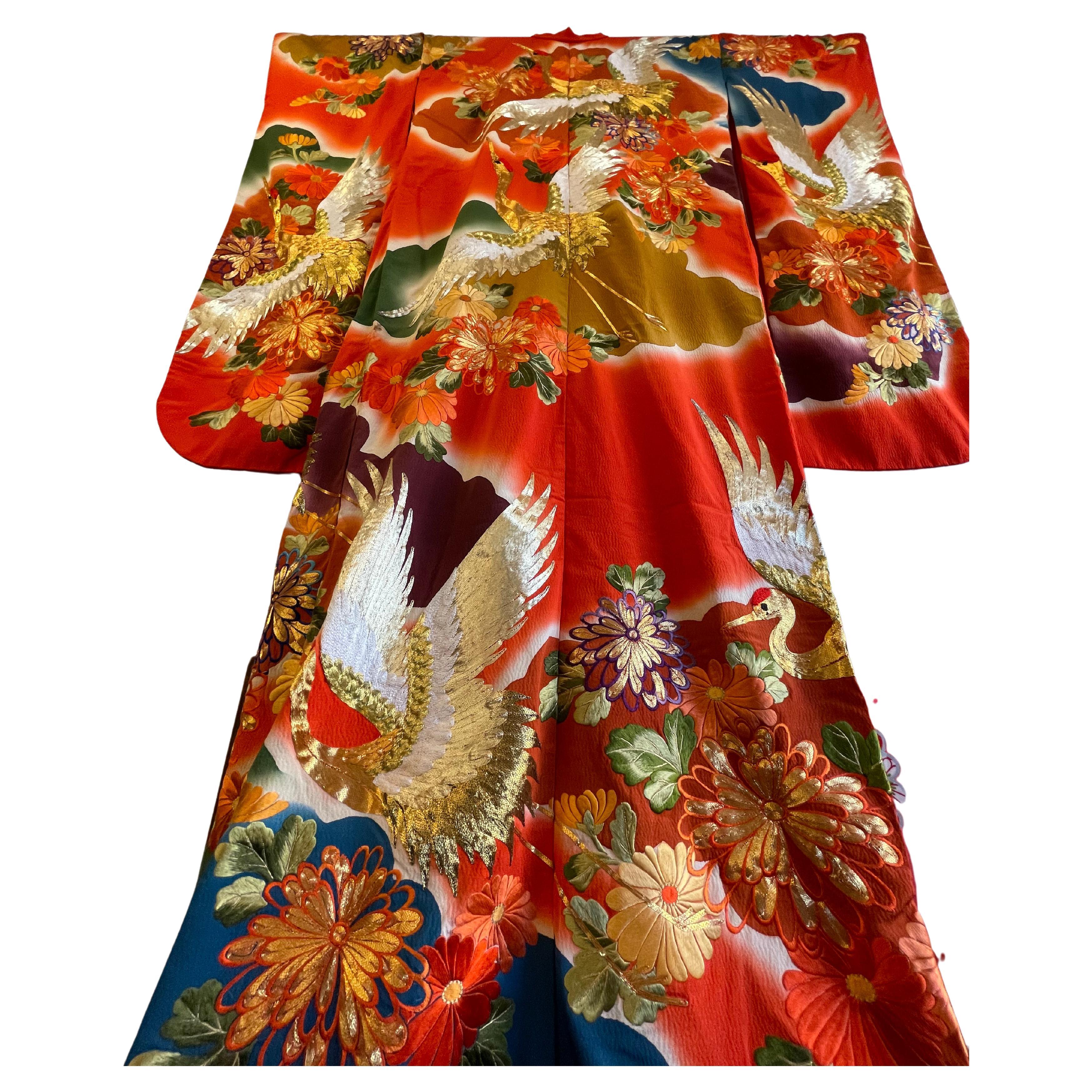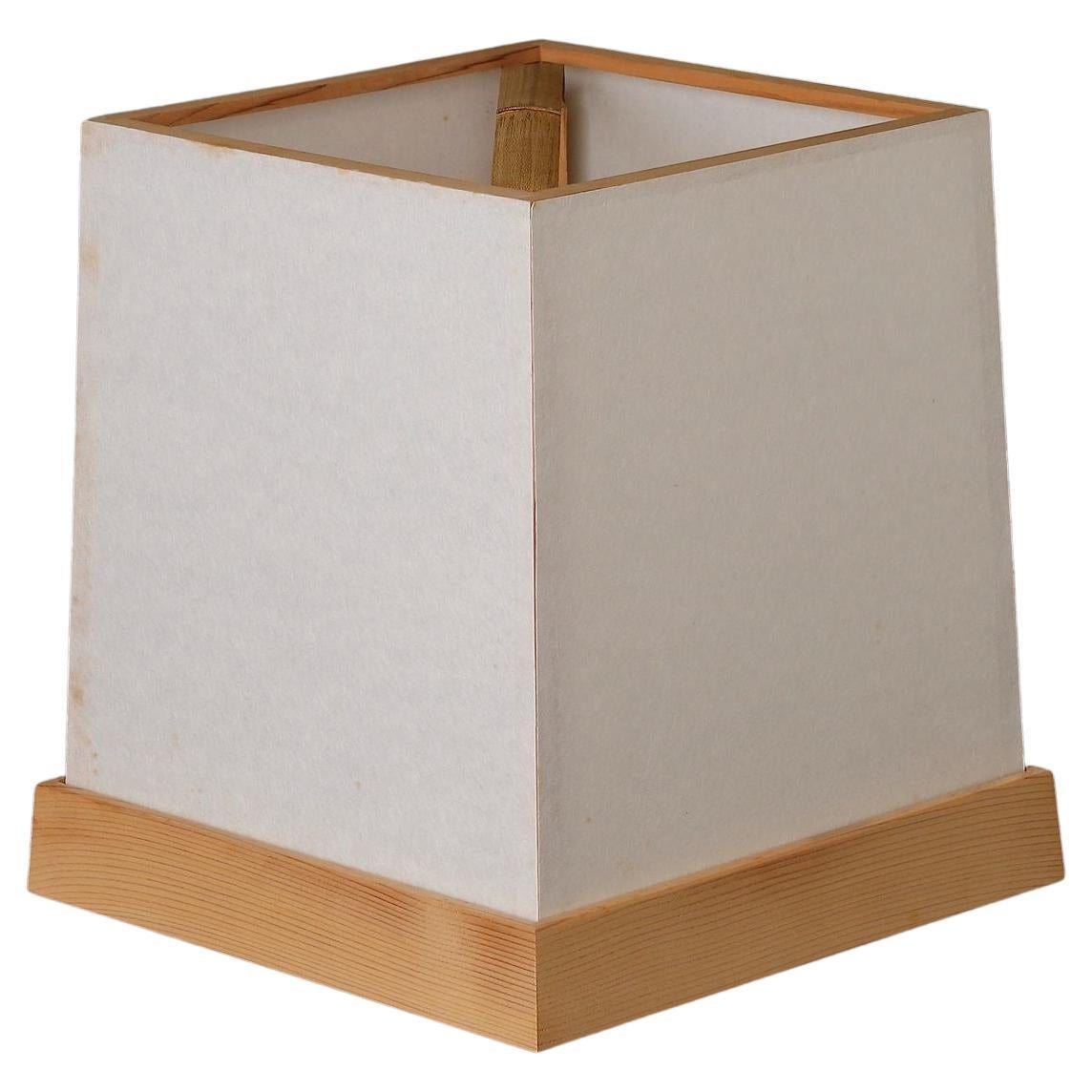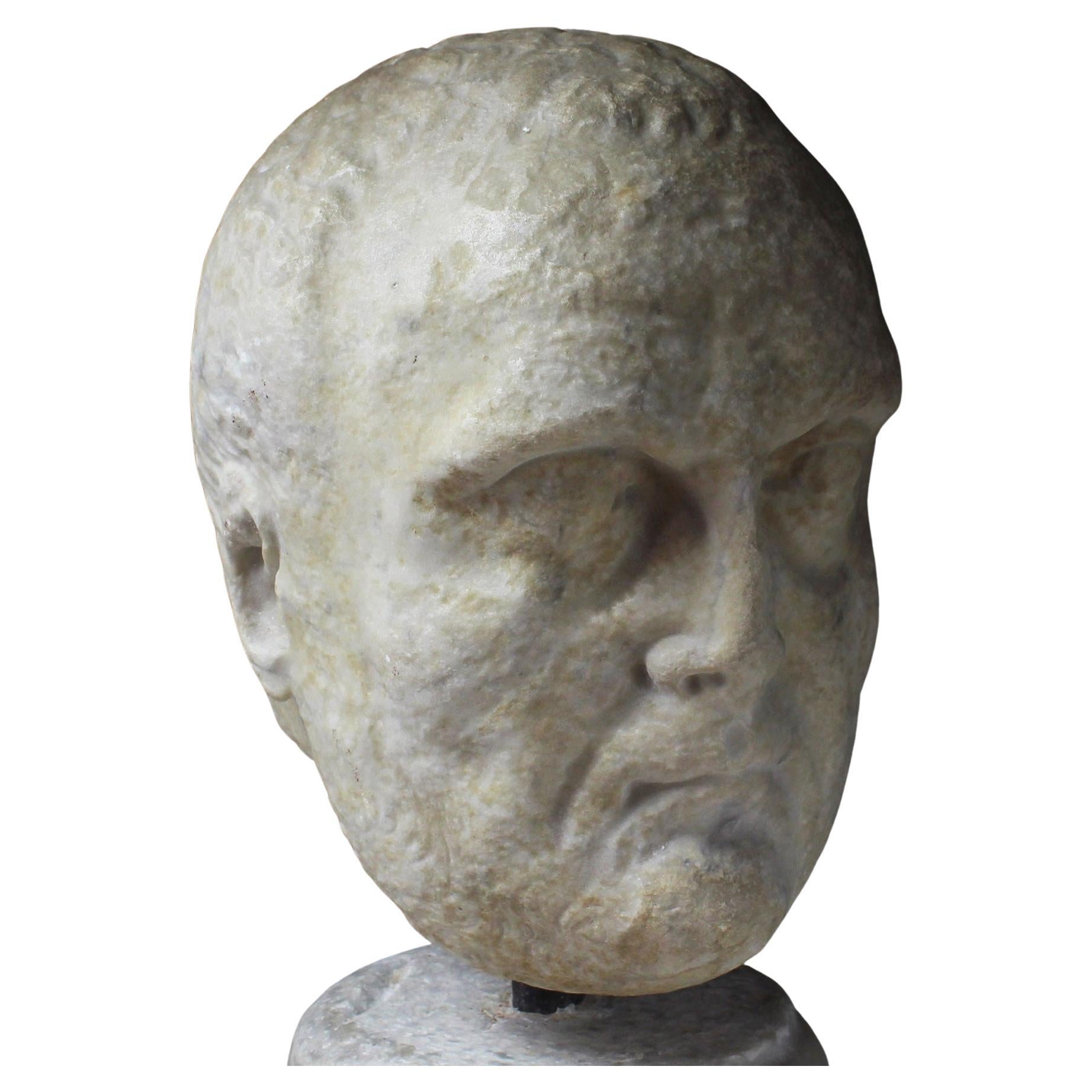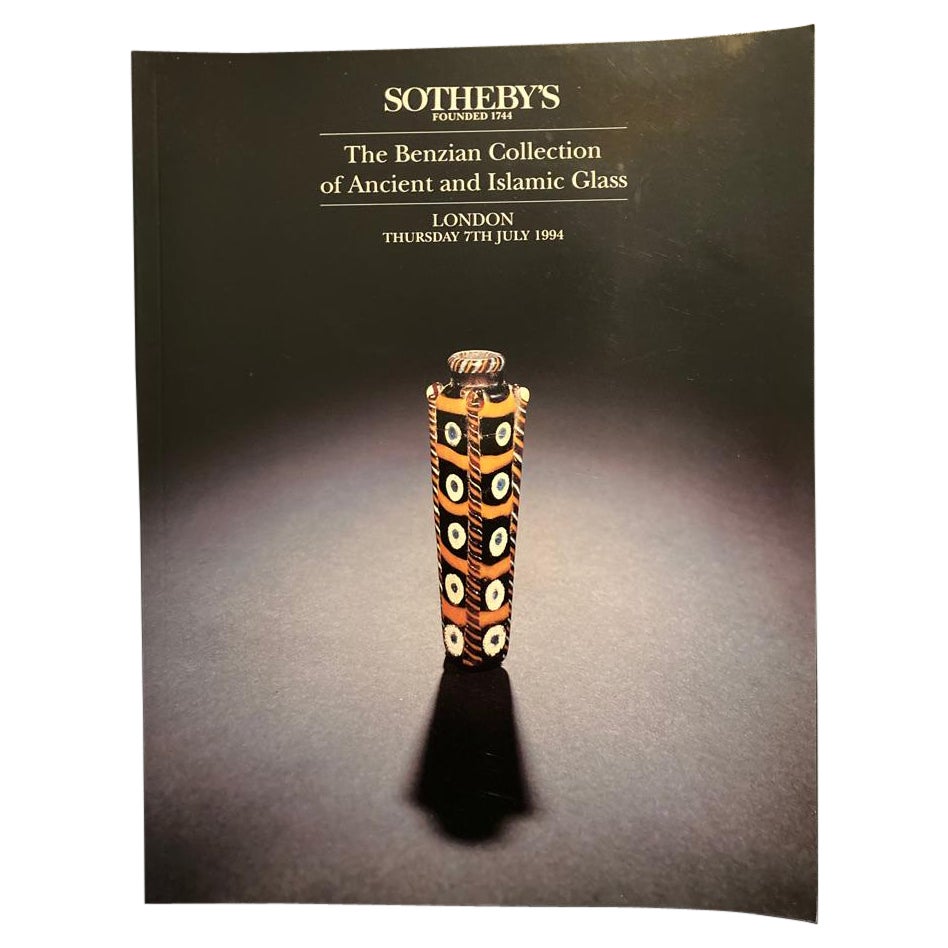Items Similar to Epitaph for Quirinia Felicia
Want more images or videos?
Request additional images or videos from the seller
1 of 5
Epitaph for Quirinia Felicia
About the Item
A rectangular marble slab carved with the Latin inscription ‘QVIRINIAE C(retr.) L / FELICLAE / OLLAM DAT / C VALERIVS PYLODAMVS’, which translates as ‘Gaius Valerius Pylodamus gave the burial urn to the freedwoman Quirinia Felicia’. This is a tablet to the memory of Quirinia Felicia, who had been born a slave and later freed by her owner.
The vast majority of surviving Roman inscriptions date from the imperial period – between the reign of the first emperor Augustus (27 B.C. – 14 A.D.) until the third century A.D.. Although it is impossible to estimate the number of surviving Roman inscriptions, it must run into the hundreds of thousands, with archaeologists continuing to uncover more. Epigraphic material such as this provides information about many different aspects of the Roman world, including political, social, and economic features of people’s daily lives. Funerary monuments make up the largest group of Roman inscriptions. The specific details recorded about the deceased, often including their age, occupation, and life history, provides key insight into Roman society.
Exhibited
Writing and Lettering in Antiquity, Folio Fine Art Ltd., London, 9-20 October 1970, no. 52.
Published
Guilelmus Henzen, Johannes Baptista de Rossi, Eugenius Bormann, Corpus Inscriptionum Latinarum, vol. 6, part 4, fasc. 1, ed. Christianus Huelsen (Berlin, 1884), p. 2537, no. 25338.
Writing and Lettering in Antiquity, Folio Fine Art Ltd., London, 9-20 October 1970, no. 52.
Heikki Solin, ‘Analecta Epigraphica’, Arctos: Acta Philologica Fennica, XVI (1982), p. 202.
Alessandro Teatini, I Marmi Reksten e il Collezionismo Europeo di Antichità tra XVII e XIX Secolo (Rome, 2003), p. 128.
Adelina Ramundo, ‘Caratteri e trasformazioni del paesaggio urbano delle vigne intorno a S. Cesareo’, PhD thesis (Roma Tre University, Rome, 2012), p. 242.
Epigraphic Database Roma, EDR129669.
Trismegistos Database, no. 587590.
Provenance
Reportedly found during excavations at the gardens of the Collegio Clementino, Rome, 1731-1733.
Previously in the Private Collection of Francesco Ficoroni (1664-1747), Rome, circa 1733-1735.
Private Collection of William Ponsonby, 2nd Earl of Bessborough (1704-1793), Parkstead House, Roehampton.
Private Collection of William Lowther, 2nd Earl of Lonsdale (1787-1872), Lowther Castle, Lowther, Penrith, acquired from the above, most likely between 1842 and 1872 and recorded in the c. 1879 catalogue Ancient Sculpture at Lowther Castle, by W. Atkinson.
Most likely sold at: Egyptian, Western Asiatic, Greek, Etruscan and Roman Antiquities; Islamic Pottery and Metalwork; Tibetan Tankas and Indian Art; African, Oceanic, and Pre-Colombian Art, Sotheby’s, London, 29 June 1970, Lots 172-176.
With Folio Fine Art Ltd., London, from at least October 1970.
ALR: S00235748, with IADAA Certificate, this item has been checked against the Interpol database.
- Dimensions:Height: 5.01 in (12.7 cm)Width: 6.82 in (17.3 cm)Depth: 1.38 in (3.5 cm)
- Style:Classical Roman (Of the Period)
- Materials and Techniques:
- Place of Origin:
- Period:
- Date of Manufacture:circa 0 to 500 B.C
- Condition:
- Seller Location:London, GB
- Reference Number:
About the Seller
5.0
Vetted Seller
These experienced sellers undergo a comprehensive evaluation by our team of in-house experts.
Established in 1910
1stDibs seller since 2020
- ShippingRetrieving quote...Ships From: London, United Kingdom
- Return PolicyThis item cannot be returned.
More From This SellerView All
- Two Glass Inlay PairsLocated in London, GBTwo pairs of two halves from the same bar, finely detailed, with pointed ears and eyebrows, opaque yellow face, opaque red on the mouth, nose, eyes and ears, translucent cobalt blue edges to the mouth, nose and ears, with translucent emerald green leaves above and between the translucent cobalt blue brows and eye line, translucent pink pupils, with translucent cobalt blie and opaque white snake scales below the face, in translucent cobalt blue matrix, cut in the lower part of a cartouche design. These rare heads might represent the Agathos Daimon, the tutelary deity of Alexandria, who was also identified with Serapis, the male counterpart of Isis-Thermouthis (who in turn was a graecisized form of the early snake harvest goddess Renenutet). In a statue of Isis-Thermouthis in Alexandria museum (no. 25773, ex-collection King Farouk I), reproduced in Gotten, Pharaonen, no. 151, the snake goddess...Category
Antique 15th Century and Earlier Egyptian Antiquities
MaterialsGlass
- Ancient Marble Portrait Bust of a Bearded Man possibly Lucius VerusLocated in London, GBThis impressive bust is depicted with head turned slightly to the right and gaze lifted. His eyes are articulated, with the pupils indicated with a drill, giving the face a striking realism. The shoulders are draped with a cloak. Straight brows sit beneath a mass of thickly curling hair, which continues to a full beard. It is worked with great skill, evident in the heavy drill work articulating and highlighting the voluminous curls, and the highly polished surfaces, giving the appearance of soft skin. The contrast between these textures gives a chiaroscuro affect which is one of the main traits of the best Antonine busts. Roman marble portraits reached their apotheosis of craftmanship and technique under the Antonine emperors, as is evidenced in this masterful bust. The evolution of the style may be traced back to the emperor Hadrian, who was the first emperor to wear a full beard. The articulation of pupils and iris appears on busts of his lover Antinous, a novelty which continued in later Antonine portraits, such as this one. The features of this bust point to a possible identification of Emperor Lucius Verus...Category
Antique 15th Century and Earlier Antiquities
MaterialsMarble
- Bowl with Kufic InscriptionLocated in London, GBGlazed ceramic bowl with a convex wall and everted rim. With a cobalt blue inscription in the centre which reads, “baraka li-sahibihi” (blessing to its owner). Ceramics such as t...Category
Antique 15th Century and Earlier Antiquities
MaterialsCeramic
- Ancient Lustre Bowl with an IbexLocated in London, GBSmall shallow earthenware bowl decorated with lustre. With rounded sides and an everted rim, resting on a low foot-ring. Covered in an opaque white, probably tin, glaze with gold-bro...Category
Antique 15th Century and Earlier Iraqi Antiquities
MaterialsCeramic
- 'Bellon' VaseLocated in London, GBA baluster-shaped ceramic vase with siliceous paste painted in manganese and cobalt, under a transparent glaze. With hand painted blue and white decorations. Stone paste or ‘fritware’ vessels with lustre, turquoise, white and cobalt blue glazes were famously crafted in the northern Syrian city of Raqqa, situated on the Euphrates River. They were often utilitarian in design, but elegant and intricate in decoration. This present example was most likely used as a storage vessel. Like many transportable ceramics in the region, it is possible this piece was exported out of the city, either to be traded or as a container for more expensive goods. Published Collection H Hoffmann...Category
Antique 15th Century and Earlier Antiquities
MaterialsCeramic
- Ushabti for ImenmesLocated in London, GBA mummiform ushabti in blue faience. Four registers of hieroglyphic characters are painted around the lower half of the ushabti, with a vertical column of hieroglyphs in the centre o...Category
Antique 15th Century and Earlier Egyptian Egyptian Antiquities
MaterialsFaience
You May Also Like
- Scarab with prenomen for Amenhotep IILocated in EL CAMPELLO, ESITEM: Scarab with prenomen for Amenhotep II MATERIAL: Steatite CULTURE: Egyptian PERIOD: New Kingdom, XVIIIth Dynasty, 1143 – 1417 B.C DIMENSIONS: 15 mm x 11 mm CONDITION: Good condi...Category
Antique 15th Century and Earlier Egyptian Egyptian Antiquities
MaterialsStone
- Antique Japanese Kimono 'Uchikake' for Wedding, 1970sLocated in Paris, FRThis is a kimono called Uchikake which Japanese women wear for wedding ceremony. It is said that the women wear the white uchikake for the reason of 'they can dyed in any color' and...Category
Late 20th Century Japanese Showa Antiquities
MaterialsSilk
- Japanese Andon Paper Lantern for Tea CeremonyLocated in Fukuoka, JPA Beautiful Japanese Andon Lantern for Tea Ceremony. This beautiful Japanese andon lantern is a stunning example of Japanese craftsmanship. It is made o...Category
20th Century Japanese Showa Antiquities
MaterialsWood, Paper
- Roman portrait head of a PatricianLocated in EL CAMPELLO, ESITEM: Portrait head of a Patrician MATERIAL: Marble CULTURE: Roman PERIOD: 1st Century B.C DIMENSIONS: 250 mm x 175 mm x 215 mm (without stand), Life-siz...Category
Antique 15th Century and Earlier European Classical Roman Antiquities
MaterialsMarble
- Roman Trapezophorum 'Table Leg' with the Head of a PantherLocated in EL CAMPELLO, ESITEM: Trapezophorum (table leg) with the head of a panther MATERIAL: Marble CULTURE: Roman PERIOD: 2nd – 3rd Century A.D DIMENSIONS: 492 mm x 170 mm x 200 mm CONDITION: Good con...Category
Antique 15th Century and Earlier Classical Roman Antiquities
MaterialsMarble
- Sotheby's Antiquities Catalog Benzina Collection of Ancient Glass July 1994Located in Stamford, CTSotheby's auction catalog of the exceptional Benzian Collection of Ancient and Islamic Glass. An invaluable reference for the collector, scholar or anyone interested in the most delicate and beautiful of antiquities, ancient glass...Category
20th Century English Classical Roman Books
MaterialsPaper
Recently Viewed
View AllMore Ways To Browse
Cizhou Pillow
Chinese Cabinets Cape Town
Mid Century Modern Hollywood Regency
1970 Leather Chairs
2 Tone Furniture
Curved Side Chairs
Couch 1970s
Garden Furniture Bronze
Dining Table Trolley
Small 2 Table
Heavy Chair
Black Contemporary Coffee Table
Pair Of Murano Lights
Aluminum Wall Art
Wool Overdyed Area Rugs
Art Deco Frosted Art Glass
Teak Coffee Tables Coffee
1970s Czech





